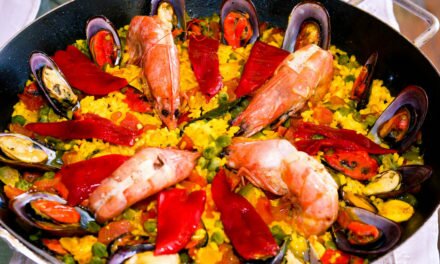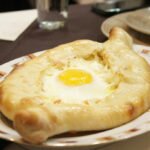CNN goes on a culinary journey with two Michelin-starred chef, Shinobu Namae to discover how Japan’s rich history of hospitality is simply a way of life. One of the traditions at the heart of Japanese hospitality is the tea ceremony. Having introduced this service at his own Tokyo restaurant, L’Effervescence, he meets with a tea master to study the significance of this ritual.
He then travels to Japan’s original capital Kyoto, which still remains a cultural cornerstone of the country. At tea producer Marukyu Koyamaen, Namae gets a taste of the highest quality green powdered tea known as matcha and learns the delicate balance it takes to grow the best tea. As tea is an integral part of the traditional multi-course meal known as kaiseki, Namae visits two famed chefs to discover how tapping into seasonality is part of creating unforgettable culinary experiences for their guests.
For his final celebration, Namae heads back toward Tokyo to Terada Honke, a sake brewery that has been in operation for more than 300 years. As he picnics amongst the rice fields with a few friends, he honors the ingredients and craftsmanship of Japan with a childhood favorite food and of course, a final cup of matcha tea.
Photo credit: CNN/’Culinary Journeys’
What inspired you to cook? And what compose your culinary philosophy?
Cooking is all about making something by hand to make someone happy. My philosophy is to be sincere to everything around you, love who you are and what you do.
You hold a diploma in Politics from one of the top universities in Japan, Keio University, but it’s not a career you pursued. Becoming a chef must have been quite an interesting journey for you. Can you tell us about it?
A lot of people been asking me this question but it was quite natural for me to get into the world of cuisine. When I was studying, I needed to earn money to support myself. So I started working part-time at an Italian restaurant at night and went to school in the morning. I needed to survive and this job fed me a delicious and warm meal at the end of the day. That was my starting point and it was really simple.
I love people and I am interested in Social Science, and I wanted to understand people’s difference in different aspects including culture, generations, gender, religions etc. Learning politics was all about how to cope with these differences. And now finding the beauty of different food cultures is another way to fulfill my interest.
Why have you decided to do French cuisine instead of Japanese cuisine?
My mentor Michel Bras is a French chef. And I was interested in learning something different so I started from European cuisine.
You’ve had experience in the kitchens at Heston Blumenthal’s The Fat Duck and Michel Bras’ three-Michelin-starred restaurants – what did you learn from your time there?
Both chefs are unique and have extreme curiosities about nature and science. They are both self-taught chefs, creating dishes from nature.
Photo credit: CNN/’Culinary Journeys’
Tell us about your ‘Culinary Journey’ on CNN. What is the highlight of this journey?
Through this journey, I would like to show the very unique Japanese hospitality made by Japan’s historical background, beautiful landscape and craftsmanship. I travelled to Kyoto to meet two Kaiseki chefs and a tea master. And I completed the journey at a sake brewery in Chiba with more than 300 years history.
I thought I already knew many beautiful aspects of Japanese food culture and I realized again it’s a never an ending journey to discover all of them.
Highlights are everywhere from this journey, but I would say each person who I introduce to audience in this journey not only care about details of their craft but also care about people they encounter and serve. The warm-hearted hospitality is the most unique thing here in Japan.
In CNN ‘Culinary Journeys’, you went to Kyoto to discover the best quality Japanese green tea. And a tea ceremony is integral in the dining experience at your restaurant L’Effervescence. Tell us the importance of tea in Japanese dining culture.
The traditional Japanese fine dining, Kaiseki, is originally the meal served in the context of tea ceremony. The tea ceremony ceremony gives you a precious moment of encountering with other guests. A good cup of tea makes people united together and it has a power of magic.
Tea ceremony is an important dining experience at my restaurant because it’s the symbol of unity and peace as well as care of each other.
Will we still find hints of Japan flavors in L’Effervescence menu?
Yes, very much. I put some Japanese technique behind European composition, but I try not to make it too prominent in one side of the culture on my dishes. But almost all ingredients are sourced from all over Japan now.
Photo credit: CNN/’Culinary Journeys’
How would you describe Tokyo’s culinary scene?
A lot of new restaurants opened by younger generations are rising.
If we gave you a blank check, where would your dream culinary journey take you and what would you do there?
Ethiopia. The starting point of “The great journey of human being”. I believe I can find something very important in this country of many tribes. And I am interested in “Gursha” – grabbing a morsel of food and place into the mouth of someone else at the table. Then the person you have just honored with a “Gursha” returns the favor. It’s about making the friendship and love stronger.
And great coffee too.
What does Michelin recognition mean to you?
It’s good to be recognized but I try to be humble and generous. I don’t mind being called a celebrity chef or so, but I am still who I am. Nothing more or less after recognized by Michelin.
What do you usually like to cook when you are at home?
Something simple like vegetables with some seafood. And I enjoy having sake and wines.
Interview with Shinobu Namae courtesy of CNN’s ‘Culinary Journeys’.
Learn more about the program here, and join the social conversation on Twitter and Instagram #CNNFood






